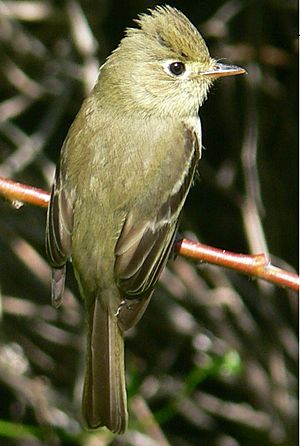Western flycatcher facts for kids
Quick facts for kids Western flycatcher |
|
|---|---|
 |
|
| Conservation status | |
| Scientific classification | |
| Genus: |
Empidonax
|
| Species: |
difficilis
|
| Synonyms | |
|
|
The western flycatcher (Empidonax difficilis) is a small bird that loves to eat insects. It belongs to the Tyrannidae family. You can find this bird in western North America. It lives in the Rocky Mountains and forests along the Pacific Coast, from California all the way up to Alaska. Some western flycatchers also live south into central Mexico. Birds from the northern areas fly south to Mexico for the winter.
Contents
Discovering the Western Flycatcher
Scientists study animals to understand them better. This is called taxonomy. For a long time, the western flycatcher was thought to be just one type of bird. But in 1989, bird experts in America decided it was actually two different species. They called them the Pacific-slope flycatcher and the Cordilleran flycatcher.
Why Scientists Split Them
These two types of flycatchers looked almost exactly alike. Scientists split them because they lived in different places when they had their babies. Also, their songs and calls seemed a little different. The Pacific-slope flycatcher lived near the coast and in parts of the Rocky Mountains. The Cordilleran flycatcher lived deeper inside the Rocky Mountains. Both spent their winters in Mexico.
Rejoining the Species
Then, in 2023, the same bird experts changed their minds again! They decided to put the two types back together as one species: the western flycatcher. This happened because new studies showed they were not different enough. Their songs, genes, and looks were too similar. Also, they often had babies together in places where their homes overlapped.
Types of Western Flycatchers
Even though it's now one species, scientists recognize five slightly different groups, called subspecies:
- E. d. difficilis: Found from southeastern Alaska down to Baja California, Mexico.
- E. d. insulicola: Lives on the Channel Islands off southern California.
- E. d. cineritius: Found in the mountains of southern Baja California Sur, Mexico.
- E. d. hellmayri: Breeds in the Rocky Mountains from Canada to northern Mexico. It winters in central and southern Mexico.
- E. d. occidentalis: Lives in the Sierra Madre del Sur mountains in Mexico.
The last two groups were once thought to be the "Cordilleran flycatcher."
What the Western Flycatcher Looks Like
Adult western flycatchers have olive-gray feathers on their backs. Their wings and tail are a bit darker. Their bellies are yellowish. They have a clear white ring around their eyes that looks like a teardrop. They also have white bars on their wings. Their bill is small, and their tail is short.
Telling Them Apart
It can be tricky to tell western flycatchers apart from other Empidonax flycatchers. Many birds in this group look very similar. The best ways to identify them are by listening to their songs, seeing where they live, and knowing their usual travel paths.
In 2014, DNA tests helped scientists find a new way to tell them apart. They found a special mark on the feathers of the wings. This helps to tell them apart from yellow-bellied flycatchers.
Their Songs and Calls
The western flycatcher's song includes notes like pseet, ptsick, and seet. They usually sing these notes quickly together. For birds living near the Pacific, the ptsick note has the first part higher pitched than the second. The male bird's usual call is a loud and clear pit pete or tse-seet. Some also make a rising tsweep or a slurred tseeweep sound.
Where Western Flycatchers Live
These birds migrate to Mexico for the winter. Some western flycatchers that live in central and southern Mexico stay there all year. The birds that migrate spend their winters along the western coast of Mexico. They can be found from Jalisco northwards. They also live in a narrow strip of land in the western part of the Sierra Madre Occidental mountains.
Western Flycatcher Homes
The western flycatcher lives in different kinds of forests. These can be forests with cone-bearing trees (coniferous) or trees that lose their leaves (deciduous). They live in mixed woods, Douglas fir forests, redwood forests, and pine-oak forests. They also like other wooded areas, including forests along rivers (riparian woodlands).
Nesting and Reproduction
Western flycatchers prefer to have their babies near running water. They build a cup nest in the fork of a tree branch. The nest is usually low down on a horizontal branch. The female bird typically lays two to five eggs.
What Western Flycatchers Eat
As a flycatcher, this bird mostly eats insects. It likes to sit on a branch and wait. When it sees a flying insect, it will fly out to catch it in the air. This is called hawking. They also pick insects off leaves while hovering, which is called gleaning. Sometimes, they fly into swarms of gnats or mosquitoes to eat them.
Western flycatchers are important because they help control insect populations. They especially help by eating mosquitoes, caterpillars, and spiders.
See also
 In Spanish: Mosquero del Pacífico para niños
In Spanish: Mosquero del Pacífico para niños


